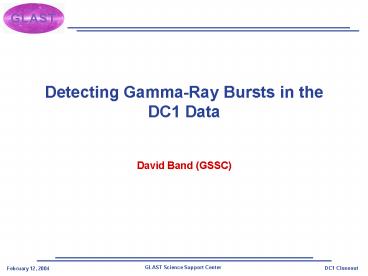Detecting Gamma-Ray Bursts in the DC1 Data
1 / 13
Title:
Detecting Gamma-Ray Bursts in the DC1 Data
Description:
GLAST Science Support Center. February 12, 2004 ... Here: Method applied to DC1 data, therefore applicable to ground ... use t=1, 2, 4, 8, and 16 s applied ... –
Number of Views:27
Avg rating:3.0/5.0
Title: Detecting Gamma-Ray Bursts in the DC1 Data
1
Detecting Gamma-Ray Bursts in the DC1 Data
- David Band (GSSC)
2
Goal
- Develop a LAT burst trigger for use on the
spacecraft and on the ground. Ground-based
trigger may be end of Level 1 pipeline or
provided to users. - Regimes
- Onboard burst photons are mixed with large
non-burst event rate. Filtering to reduce the
background will filter out burst photons. - Ground basedburst photons mixed with small
non-burst event rate. - Criteria
- Understand and control the false positive
triggers - Understand the burst detection sensitivity
- Here Method applied to DC1 data, therefore
applicable to ground-based trigger.
3
Method
- Break up sky in instrument coordinates into
regions, and apply rate triggers to each region.
The regions are PSF in size (builds in knowledge
of the instrument). - Use two (or more) staggered regions so that the
burst will fall in the interior of a region. - Rate triggerstatistically significant increase
in count rate averaged over time and energy bin.
4
Estimating the Background
- The rate trigger requires an estimate of the
background (non-burst event rate). Typically
the background is estimated from the non-burst
lightcurve. - BUT here the event rate is so low that a regions
background estimated only from that regions
lightcurve will be dominated by Poisson noise.
The event rate per region is a few10-2 Hz. - My current method is to average the background
over the FOV, and apportion it to each region
proportional to the effective area for that
region.
5
Problem with Background Estimation
- Problem On short (100 s) timescales the
background is NOT uniform over the FOV. The
ridge of emission along the Galactic plane causes
many false triggers. - Solution (not implemented yet) Better model of
the background.
Region with false trigger
6
Region in Galactic Coordinates
7
Rate Trigger
- I use ?t1, 2, 4, 8, and 16 s applied every
second. - The trigger is disabled for 100 s after each
trigger. - Because the expected number of events per region
is much less than 1, I use Poisson probabilities. - If there are 100 regions over the sky, ?t1 s,
and we allow one false positive per year, then
P0lt310-10. This was the threshold I used
fainter bursts might be found if I used a larger
P0. - Because of the problems estimating the background
the false positive rate was much higher. - See LAT_trigger_DC1.pdf or LAT_trigger_DC1.ps at
http//glast.gsfc.nasa.gov/ssc/dev/grb_tools/
8
Sensitivity and Significance
- Given ?t, P0, Aeff, and the background rate (here
3, 30 or 300 Hz), one can estimate the burst flux
for a trigger. - Here ?t1 s, Aeff104 cm2.
30 Hz Aeff/3
3 Hz
300 Hz
P0310-10
9
Results
- In the 6 days of DC1 data, I found 16 bursts and
29 false triggers. - Note that my spatial grids extend to inclination
angles of 65º and 70º. - The software I used was all home-grown IDL
procedures.
10
More Plots
Note the absence of non-burst events!
Grids inappropriate for this burst
11
The Detected Bursts
Day Time (s) RA (deg) Dec (deg) Cts
1 3001 200.166 -32.2983 51
1 11045 326.629 27.3368 12
1 19064 138.961 -34.7865 15
1 23140 19.0295 25.6420 12
1 27212 259.142 -15.8457 12
1 35237 259.142 -15.8457 15
1 43256 145.960 33.9054 14
1 71387 225.893 -33.7395 26
1 75438 92.0570 56.3619 363
1 83511 200.164 -32.4890 21
3 176749 128.730 64.5720 257
3 215701 251.497 27.6858 161
3 220441 134.975 -2.80631 35
5 386296 198.924 33.8185 14
5 402116 128.528 -44.1544 14
5 410281 236.190 41.7744 108
Time givenend of time bin that first
triggered Ctscts within 5º
12
Improvements to THIS Method
- Better background
- Improve grid
- Better staggered or more grids?
- Different region size?
- Alternatively, HTM or HEALPIX pixels?
- Time bin stridetest time bins every ½ time bin?
- Operationally, increase P0 when GBM triggers?
13
Lessons Learned
- The major issue for this method (and probably all
spatial-temporal triggers) is estimating the
background (non-burst event rate). The event
rate is NOT uniform over the FOV on short
timescales. - Useful plots
- Count map of sky in different coordinate systems
(instrument, celestial, Galactic) over specified
time range. Control over plotting limits
necessary. - Lightcurve of counts from specified spatial area
(e.g., circle around burst location). Control
over plotting limits, circle radius, burst
location necessary.































